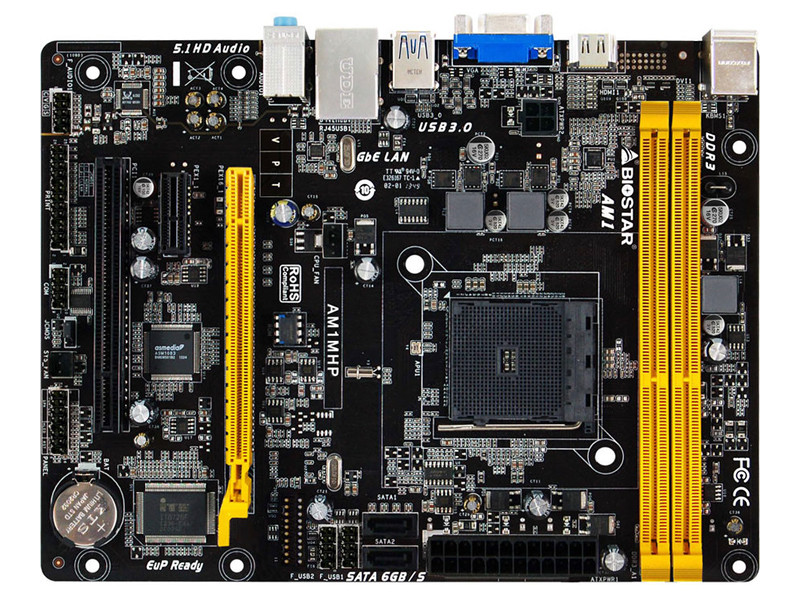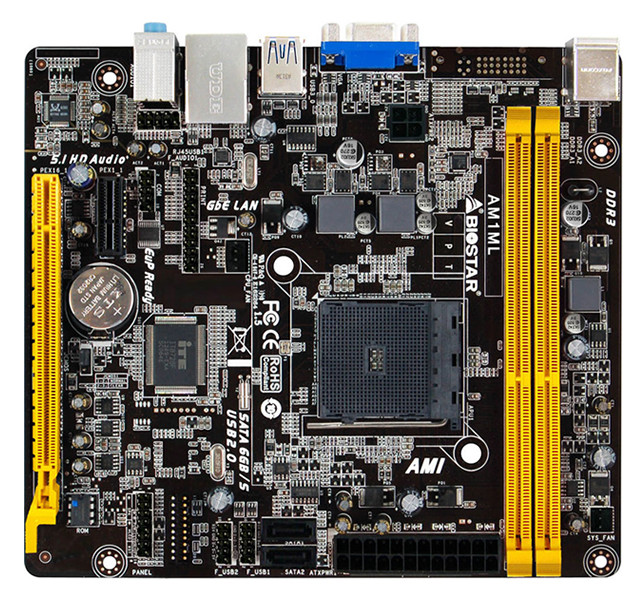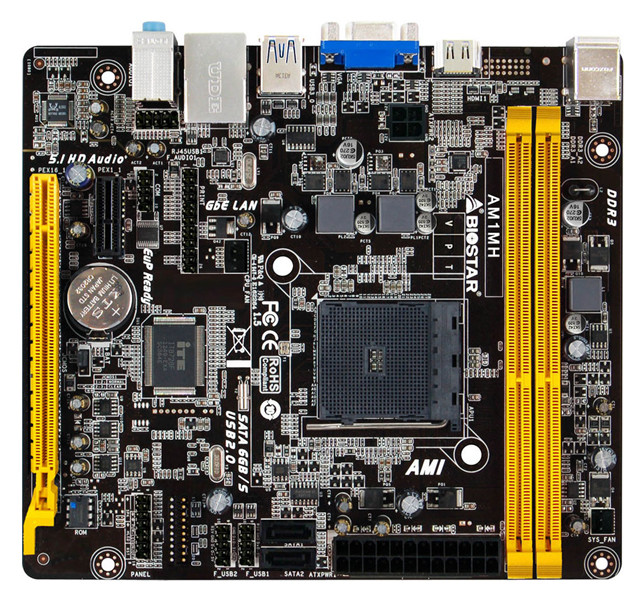Biostar Reveals Lineup of Socket AM1 Motherboards
Biostar has announced three socket AM1 motherboards.
Biostar has announced a triplet of socket AM1 motherboards, which are also the first AM1 motherboards the company has built. The three motherboards are largely identical to each other, with a couple of subtle differences.
They'll be known as the AM1MHP, AM1MH and AM1ML. All three motherboards come in the Micro-ATX form factor, though lack one or two expansion slots from the reference format. They all use a 2+1 phase VRM circuit to power the CPU, feature two DDR3 DIMM slots, feature a single PCIe 2.0 x16 slot, a single PCIe 1x slot, and feature two SATA3 ports.
The AM1MHP features an additional PCI slot, which the AM1MH and the AM1ML lack. The AM1MHP and the AM1MH feature VGA and HDMI ports as display outputs, while the AM1ML lacks the HDMI port.
There was no official word on pricing for these motherboards, though we expect them to be very affordable given the objectives AMD has with the AM1 platform.
Get Tom's Hardware's best news and in-depth reviews, straight to your inbox.
Niels Broekhuijsen is a Contributing Writer for Tom's Hardware US. He reviews cases, water cooling and pc builds.
-
knowom I really like this particular form factor that's a expansion slot or two smaller than the reference Micro ATX form factor, but has that extra bit of expandability that Mini ITX is just lacking.Could probably squeeze 4 so-dimm slots in this form factor if they wanted higher memory capacity options as well and 2 full size PCIe 2.0 x16 slots could likely be done as well and be pretty desirable.Nvidia should add a SLI slot to Maxwell 750 ti when it receives a die shrink and make a single slot design or dual board/dual chip design. They could pack so much GPU performance in such a tiny form factor if they did so and I don't think the heat or power would even be much concern.Whatever AMD's response is to Maxwell it should have crossfire support and be a single slot solution they'd defiantly have a hit on their hands.Reply -
lp231 @qlumReply
desktop version were socket 754, 939, 940. Then it went on to socket AM2... up to the current AMD FX, which runs on socket AM3+.
The old FX was called AMD Athlon 64 FX and it ran on socket 940.
-
waethorn The 2 boards at the bottom aren't Micro-ATX. They are a variant of Mini-ITX called Mini-DTX. It differs from ITX in that it allows for 2 expansion slots instead of 1. The holes line up with ITX, and any case designed for ITX that has 2 slot covers is technically a DTX case (unless the case is designed for a PCI riser like some of the gaming-centric SFF cases like those used for Steam Machines and such).Reply -
waethorn So far, the Asrock Mini-ITX model still looks like the model to beat. It has 7.1 analog audio hookups, mini-PCIe for optional WLAN (I wish it was mSATA though - straight mPCIe SSD's are impossible to find anymore), and DC input as an option (for use with ultra-small cases).Zotac seems to be always be pretty feature-competitive with their ITX motherboards though. Perhaps if they release one, it'll have the WLAN features included and will ship with antennae.Reply -
waethorn Reply12840132 said:Its not a CPU socket, its a SoC socket *drops mic*
True, but all main PC processors are moving to SoC designs anyway. AMD says that the standalone FX CPU's days are numbered, and Intel has said that future chips of theirs will be SoC's as well. The good news with this is that you don't have to repurchase a motherboard if the socket (and voltage) are the same in a future chip upgrade because the board just becomes a cheap chip "dock" for connections and you only have additional chips if there is a need for supplemental connection controllers. Even so, it becomes far less expensive because you no longer have a traditional chipset soldered to the board. The bad news is that Intel says that post-Haswell chips will all be soldered BGA only (which AMD says they're not doing any time soon), so you'll have to buy a new motherboard anyway. What the customer could've gained by getting an entire processor and chipset in one is lost with a soldered design.
-
waethorn Tell me something: if the PCI-e controller is now in the SoC, does that mean that if a future AM1 chip comes with enough PCI-e lanes to support a PCI-e x16 slot, then can an existing AM1 motherboard with a physical x16 slot will support a video card at "full" speed?Reply
I guess it would also depend on whether or not socket AM1 has enough pins to handle that too, right?
*Note to TOM'S*: please do a big review on AM1 when more parts are made available and dig into this question a bit deeper. I'd like to know more about future upgradeability potential with the platform. Some of these questions will undoubtedly come up with higher-end mainstream platforms such as the post-Kaveri A-series SoC's as well as Intel's future mainstream SoC platform.



